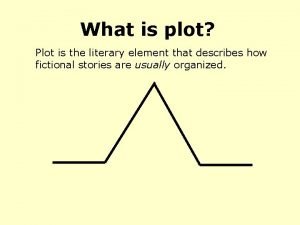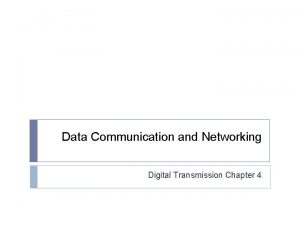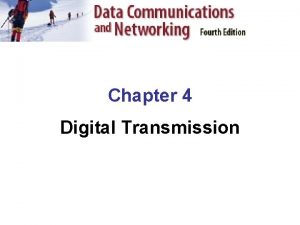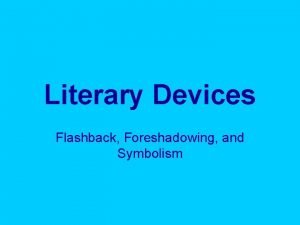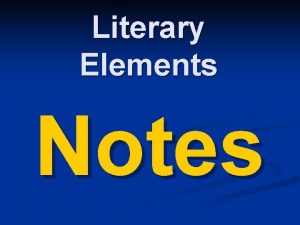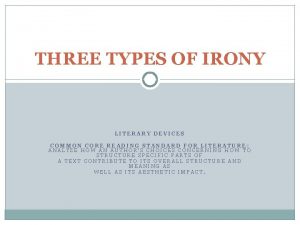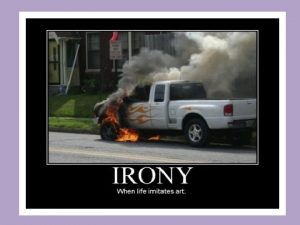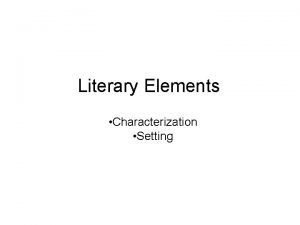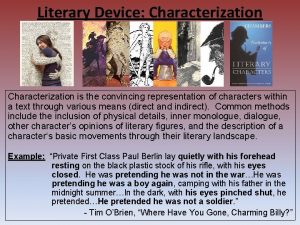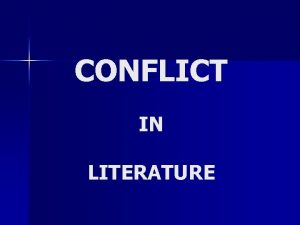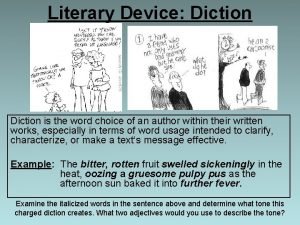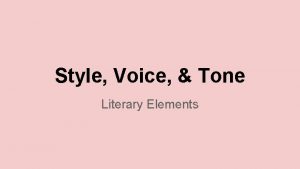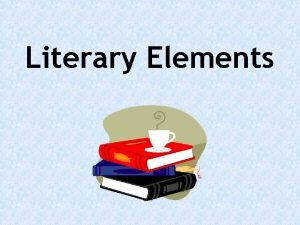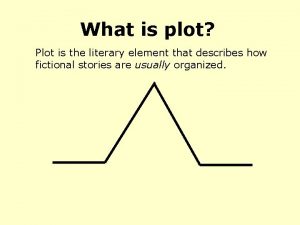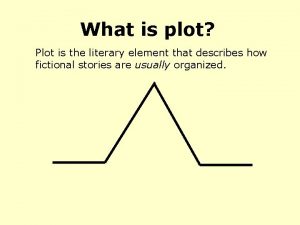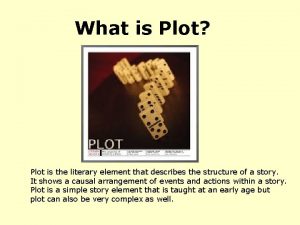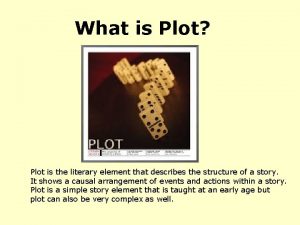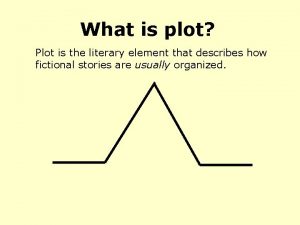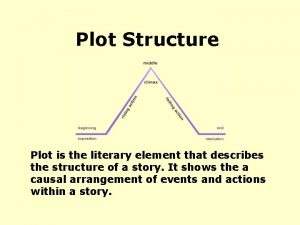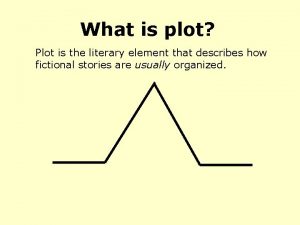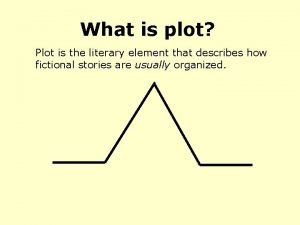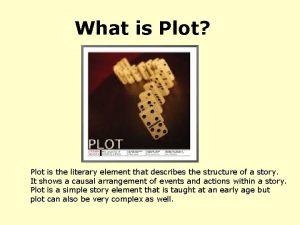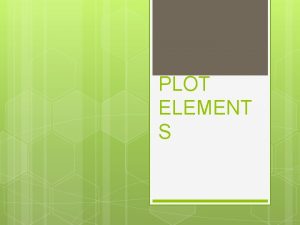What is Plot Plot is the literary element
















- Slides: 16

What is Plot? Plot is the literary element that describes the structure of a story. It shows arrangement of events and actions within a story.

Plot Summary Flow Chart

INTRODUCTION: Also called the exposition, the reader is introduced to the characters, setting, and background information.

: N O I T AC G N I RIS ory t s e h As t , s e s s progre ations and lic p m o c ise r a r. s e t m c e l a r b a pro ch n i a m e h t r o f These es create lti u c i f f i d. e s n e susp INTRODUCTION/EXPOSITION: Also called the exposition, the reader is introduced to the characters, setting, and background information.

Climax: This is the highest point of interest or drama in the story. The suspense is at its peak, but the outcome is still unclear. TION: sses, C A G se RISIN tory progre oblems ari s pr As the ations and hese T. r e t c li c comp chara pense. n i a m us for the es create s lti difficu INTRODUCTION/EXPOSITION: Also called the exposition, the reader is introduced to the characters, setting, and background information.

CLIMAX: This is the highest point of interest or drama in the story. The suspense is at its peak, but the outcome is still unclear. FAL L ACT ING The ION/D ENO t e n relie sion UEM v has ed. ENT r e : N T b s O : een he c olve ACTI gresses, e G s i N r I a d an onfl cha RIS lems ry pro b o t o r s p e ict i r d a se e As th ations and c h T t. s e t o lic cter r p a r s m a. n o h ’ live c orm ain c pense s m u e s h t e term s re al. N for creat s e i t l t u diffic Den s Fallin ote tha urn o com ueme g Actio t the nt a n b i n ed. re o and all e In th ften ven Clim ts a is c ase f a t e x r Den fall , INTRODUCTION/EXPOSITION: the u o uem nder Also called the exposition, the ent. reader is introduced to the characters, setting, and background information.

CLIMAX: This is the highest point of interest or drama in the story. The suspense is at its peak, but the outcome is still unclear. TION: sses, C A G se RISIN tory progre oblems ari s pr As the ations and hese T. r e t c li c comp chara pense. n i a m us for the es create s lti difficu INTRODUCTION/EXPOSITION: Also called the exposition, the reader is introduced to the characters, setting, and background information. FAL L The ING A C relie tension TION / reso ved. Th has be DENO UEM cha lved an e confl en ENT ict i ract d : s e to n orm rs’ live term s re al. N turn s o t F e Den allin t h a o com ueme g Actio t the n n all e bined. t are o and I f v Clim ents a n this c ten a f Den ax fall ter the se, u oue men nder t. RESOLUTION: Also called the denouement, it is the final resolution of the main complication. The term denouement applies only to stories with happy endings. Tragic endings are termed catastrophe.

Plot is the literary element that describes the structure of a story. It shows arrangement of events and actions within a story.

Plot Components Climax: the turning point, the most intense moment—either mentally or in action Rising Action: the series of conflicts and crisis in the story that lead to the climax Falling Action: all of the action which follows the climax Exposition: the start of the story, the situation before the action starts Resolution: the conclusion, the tying together of all of the threads

Conflict: Conflict is the dramatic struggle between two forces in a story. Without conflict, there is no plot.

Types of Conflict: Character vs Nature Character vs Society Character vs Self Known as Internal Conflict

Character vs. Character Conflict This type of conflict finds the main character in conflict with another character, human or not human. “The new one is the most beautiful of all; he is so young and pretty. ” And the old swans bowed their heads before him. Then he felt quite ashamed, and his head under his wing; for he did not know what to do, he was so happy, and yet not at all proud. He had been persecuted and despised for his ugliness, and now he heard them say he was the most beautiful of all the birds. The Ugly Duckling by Hans Christian Anderson

Character vs. Nature Conflict This type of conflict finds the main character in conflict with the forces of nature, which serve as the antagonist usually the main villain or main obstacle to the protagonist, or hero of the story. It´s a Truffula Seed. It´s the last one of all! You´re in charge of the last of the Truffula Seeds. And Truffula Trees are what everyone needs. Plant a new Truffula. Treat it with care. Give it clean water. And feed it fresh air. Grow a forest. Protect it from axes that hack. Then the Lorax and all of his friends may come back. The Lorax by Dr. Seuss

Character vs. Society Conflict This type of conflict has the main character in conflict with a larger group: a community, society, culture, etc. “I’m tired of living in a hole, ” said Jenny. “Let’s fight for freedom!” cried Bouncer. “We’ll be soldiers! Rough-riding Rowdies! I’ll be the general and commander-in-chief!” The Island of the Skog by Steven Kellogg

Character vs. Self Conflict known as Internal Conflict In this type of conflict, the main character experiences some kind of inner conflict.

Thanks for your attention! This concludes my presentation on Plot and its parts!!!
 What is plot
What is plot Is plot a literary element
Is plot a literary element What is plot
What is plot What is subplot in literature
What is subplot in literature Difference between data element and signal element
Difference between data element and signal element Signal element vs data element
Signal element vs data element Literary elements examples
Literary elements examples Literary element flashback
Literary element flashback Literary elements symbolism
Literary elements symbolism Literary element irony
Literary element irony Irony literary element
Irony literary element Is characterization a literary element
Is characterization a literary element Where have you gone charming billy answer key
Where have you gone charming billy answer key Is conflict a literary element
Is conflict a literary element Diction literary device
Diction literary device Style in literature
Style in literature Story elements cinderella
Story elements cinderella
